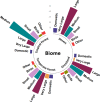Dietary patterns of a versatile large carnivore, the puma (Puma concolor)
- PMID: 35784054
- PMCID: PMC9240727
- DOI: 10.1002/ece3.9002
Dietary patterns of a versatile large carnivore, the puma (Puma concolor)
Abstract
Large carnivores play critical roles in terrestrial ecosystems but have suffered dramatic range contractions over the past two centuries. Developing an accurate understanding of large carnivore diets is an important first step towards an improved understanding of their ecological roles and addressing the conservation challenges faced by these species.The puma is one of seven large felid species in the world and the only one native to the non-tropical regions of the New World. We conducted a meta-analysis of puma diets across the species' range in the Americas and assessed the impact of varying environmental conditions, niche roles, and human activity on puma diets. Pumas displayed remarkable dietary flexibility, consuming at least 232 different prey species, including one Critically Endangered and five Endangered species.Our meta-analysis found clear patterns in puma diets with changing habitat and environmental conditions. Pumas consumed more larger-bodied prey species with increasing distance from the equator, but consumption of medium-sized species showed the opposite trend.Puma diets varied with their realized niche; however, contrary to our expectations, puma consumption of large species did not change with their trophic position, and pumas consumed more small prey and birds as apex predators. Consumption of domestic species was negatively correlated with consumption of medium-sized wild species, a finding which underscores the importance of maintaining intact native prey assemblages.The tremendous dietary flexibility displayed by pumas represents both an opportunity and a challenge for understanding the puma's role in ecosystems and for the species' management and conservation. Future studies should explore the linkages between availability and selection of primary and other wild prey, and consequent impacts on predation of domestic species, in order to guide conservation actions and reduce conflict between pumas and people.
Keywords: diet; feeding ecology; large carnivore; predation; puma.
© 2022 The Authors. Ecology and Evolution published by John Wiley & Sons Ltd.
Conflict of interest statement
The authors declare no conflict of interest.
Figures


References
-
- Ackerman, B. B. , Lindzey, F. G. , & Hemker, T. P. (1984). Cougar food habits in southern Utah. The Journal of Wildlife Management, 48(1), 147–155. 10.2307/3808462 - DOI
-
- Allen, M. L. , Elbroch, L. M. , Casady, D. S. , & Wittmer, H. U. (2015). Feeding and spatial ecology of mountain lions in the Mendocino National Forest, California. California Fish and Game, 101(1), 51–65.
-
- Anderson, A. E. (1983). A critical review of literature on puma (Felis concolor). Colorado Division of Wildlife Special Report No. 54. Denver.
-
- Athreya, V. , Odden, M. , Linnell, J. D. , Krishnaswamy, J. , & Karanth, U. (2016). A cat among the dogs: Leopard Panthera pardus diet in a human‐dominated landscape in western Maharashtra, India. Oryx, 50(1), 156–162.
Publication types
LinkOut - more resources
Full Text Sources
Miscellaneous

